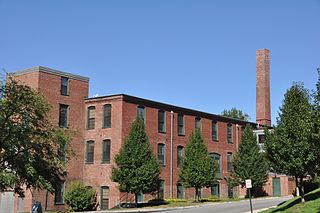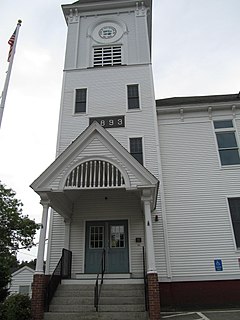
The Lake Street Fire Station is an historic fire station in Gardner, Massachusetts. Built in 1884 to house a school and a fire company, it served as a school for just a few years, and as a fire station until the 1980s. It is architecturally distinguished as a good local example of late Victorian architecture. The building was listed on the National Register of Historic Places in 1980, and included in the West Gardner Square Historic District in 1985.

The Walker Body Company Factory is a historic factory complex on Oak Street at River Court in Amesbury, Massachusetts. It has been converted to residential use.

The American Waltham Watch Company Historic District encompasses the former factory of the Waltham Watch Company, the leading American watch manufacturer of the 19th century and the city's largest employer. Located on Crescent Street and the banks of the Charles River, the surviving elements of its manufacturing facility date from the 1870s to the 1910s, and include particularly fine industrial Romanesque architecture. The buildings have been converted to a variety of commercial, industrial and residential uses since they ceased being used for watchmaking in the 1950s. The complex was listed on the National Register of Historic Places in 1989.

The Blake Daniels Cottage is a historic house at 111–113 Elm Street in Stoneham, Massachusetts. Built in 1860, it is a good example of a Greek Revival worker's residence, with an older wing that may have housed the manufactory of shoe lasts. The house was listed on the National Register of Historic Places in 1984.

The Badger State Shoe Company is a classically-styled 6-story shoe factory built in 1910 in Madison, Wisconsin, a half mile north-east of the Capitol. It was added to the National Register of Historic Places on April 11, 1989.

Dow Academy was a historic school in Franconia, New Hampshire, United States. Founded in 1884, it served as the town's high school until 1958, after which its building, a Georgian Revival wood-frame building built in 1903, became a centerpiece of the Franconia College campus. The building was converted into condominium residences in 1983; it was listed on the National Register of Historic Places in 1982.

The Charles H. Hayes Building is a historic former box factory at 14-44 Granite Street, Haverhill, Massachusetts. Built in two phases, the building represents the city's industrial growth around the turn of the 20th century. It was built by Charles H. Hayes, whose business empire also included locally important shoe manufacturers, as well as forest lands in four states to supply his operations. The building was listed on the National Register of Historic Places in 2010.

The Holman & Merriman Machine Shop, also known as the Derby Shop, Goodnow Pail Factory, L. A. Carpenter Machine Shop, and Streeter Shop, is an historic industrial building at 63 Canal Street in Hinsdale, New Hampshire. This three-story brick building, built in 1837, is the only building with a clerestory roof in Hinsdale, and one of only four in the state. It is also distinctive as the only known example in the state of a building purpose-built as a large-scale cooperage. The building was listed on the National Register of Historic Places in December 2007, and the New Hampshire State Register of Historic Places in January 2007.

The Jaffrey Mills is a historic mill complex at 41 Main Street, in the central business district of Jaffrey, New Hampshire. It consists of a connected series of primarily brick buildings flanking the Contoocook River just north of Main Street. Its oldest buildings, the original mill and office building, are on the west side of the river. They were built in 1868, and feature mansard roofs and banded dentil brick cornices. The mill building has a tower that originally sported a cupola, but this was removed early in the 20th century. In 1872 the building on the east side was built, and the two sides joined by timber-frame bridges were added in 1897, at the same time the east building was extended northward. Later additions to the north of the east building include a storage area and a loading dock. The mill complex, the only 19th-century industrial complex of its type to be built in Jaffrey, was listed on the National Register of Historic Places in 1982. It has been converted into residences.

The Contoocook Mills Industrial District of Hillsborough, New Hampshire, encompasses the industrial mill complex of the Contoocook Mills, a major business in the town from the 19th century to the mid-20th century. Industry on the banks of the Contoocook River in Hillsborough began as early as 1763, when a sawmill and gristmill were operated in the area. More modern industrial activity began in 1828 with the construction of a cotton mill by Josiah Marcy. This three story timber frame building stands on the south side of Mill Street, on a granite foundation through which a raceway provide the water which powered the mill. Marcy expanded his operations, building a grist mill and saw mill before his death in 1848. The grist mill, a handsome brick building on the north side of Mill Street, was operated as such until 1884, after which it was converted into the picker building for the main mill complex.

The Hoyt Shoe Factory is a historic factory complex at 470 Silver Street and 170 Lincoln Street in Manchester, New Hampshire. It consists of two once-identical four-story brick factory buildings which face each other across Silver Street. Built in the 1890s, they housed the city's largest shoe manufacturer, an industry that gained in significance as its textile industry declined. The complex was listed on the National Register of Historic Places in 1985.

The Kimball Brothers Shoe Factory is a historic factory building at 335 Cypress Street in Manchester, New Hampshire. The four-story brick building was built in stages between 1885 and 1900, and was a prototypical structure from which the design of other period shoe factories in Manchester were built. Construction was overseen by Head & Dowst, a builder responsible for a number of area public buildings, including schools and prisons. It was funded by local businessmen seeking to diversify the local economy, and was leased to the Kimball Brothers, a leading shoe manufacturer in Lynn, Massachusetts. The building was listed on the National Register of Historic Places in 1985.

The Gov. John Butler Smith House, also now known as the Community Building, is a historic house at 29 School Street in Hillsborough, New Hampshire. The large Queen Anne Victorian is significant as one of few known residential works of a prolific New Hampshire architect, William M. Butterfield, and as the home of John Butler Smith, a principal owner of the local Contoocook Mills, who also served as governor of New Hampshire (1893–95). The building was listed on the National Register of Historic Places in 2002.

The Woodbury Mill is a historic mill building at 1 Dover Street in Dover, New Hampshire. This five-story utilitarian brick mill building was built in 1885 by the Dover Improvement Association as a factory space for small footwear manufacturers to operate in, representing an organized effort by city businessmen to attract this type of business. It was used for shoe manufacturing until 1979, and was listed on the National Register of Historic Places in 2013.

The Green Street School is a historic school building at 104 Green Street in Somersworth, New Hampshire. Built in 1890–91, it is the city's oldest surviving school, and a prominent feature of its urban core. It was converted into residences in 1983–84, and was listed on the National Register of Historic Places in 1985.

The Lehoullier Building is a historic mill tenement house at 161-169 Main Street in Somersworth, New Hampshire. Built in 1843, it is one of two surviving tenement houses of the many that once lined Main Street near the Great Falls Manufacturing Company. The building was listed on the National Register of Historic Places in 1979.

Rollinsford Town Hall is located at 667 Main Street in Rollinsford, New Hampshire. The two-story wood-frame building was designed by New Hampshire architect Alvah T. Ramsdell, and built in 1893 to house a variety of municipal services, and an auditorium. The building, still housing municipal offices, was listed on the National Register of Historic Places in 1999.

The Old Somersworth High School, also formerly the Hilltop Elementary School, is a historic school building at 17 Grand Street in Somersworth, New Hampshire. It is a three-story brick Georgian Revival building, constructed in 1927 on the site of New Hampshire's oldest high school. It was designed by Charles Greely Loring, and served as a high school until 1956 and an elementary school until 2007. The building was listed on the National Register of Historic Places in 2015.

The Nashua Gummed and Coated Paper Company Historic District encompasses a collection of former industrial buildings on the north side of the Nashua River in Nashua, New Hampshire. Located on Franklin and Front Streets west of Main Street, the complex was developed by the Nashua Gummed and Coated Paper Company, later the Nashua Corporation, beginning in the late 19th century. It was a major manufacturing and employment center for the city until mid-1990s, when the company's business declined. One of its former storehouses was converted to residences in the 2000s, and the main complex is, in 2015-16, undergoing the same process. The complex of surviving buildings was listed on the National Register of Historic Places in 2015.

The Leonard, Shaw & Dean Shoe Factory is a historic industrial property located at Rice and Peirce Streets in Middleborough, Massachusetts. Built in 1896 and repeatedly enlarged before 1911, it was home to one of the town's major employers. Now converted to residential use, the factory complex was listed on the National Register of Historic Places in 2018.























